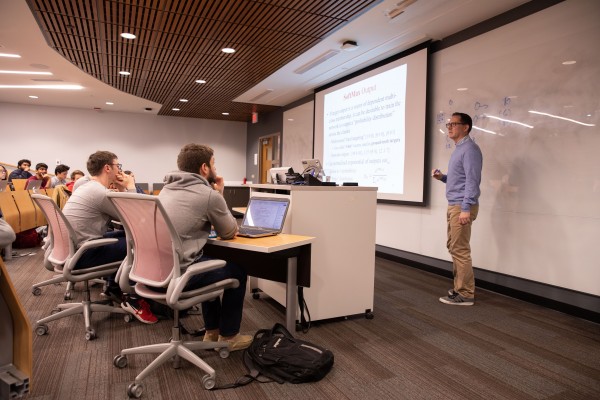
A profile in teaching: Jim Davis
Feeling as though he was often competing with Twitter, Facebook and email for his students’ attention, Professor Jim Davis decided to try something new. For the first time in his 20-year teaching career, he prohibited the use of laptops, tablets and phones in class. Accommodations were made to ensure accessibility for all students.
While a classroom limiting students’ access to these technologies might sound counterintuitive for a computer science and engineering course, Davis said it yielded one of the most interactive classroom experiences he’s encountered in decades.
Davis’ decision to go technology-free was inspired, in part, by readings on classroom improvements and student engagement that he encountered in the Teaching Support Program, a professional learning opportunity for Ohio State faculty developed by the University Institute for Teaching and Learning.
“Jim’s experience shows how even our most seasoned faculty members can learn new approaches to make the classroom experience more engaging,” said Kay Halasek, director of the University Institute for Teaching and Learning. “We aim to empower faculty to select the most effective approach for their classes — which can mean expanding the use of technology, using it in different ways, scaling back, or employing any number of other approaches to engage students, meet learning objectives and ensure accessibility for all students.”
According to Davis, the TSP was an opportunity to reflect on his pedagogy, identify gaps in his current teaching practice and implement evidence-based techniques he had never considered before.
Davis describes his experience in the TSP below.
What was your motivation for taking part in the Teaching Support Program?
It was an opportunity to examine what I currently do and compare with (evidence-based approaches from) the Teaching Support Program. I have already received teaching awards, but there is always room for improvement. Teaching is technically one thing that we are never actually trained to do. As graduate students, we may have done research, but we may have never TA’ed a class.
How has the TSP supported or changed your approach to teaching?
The Teaching Support Program really did reaffirm a lot of my existing practices, but it also opened the door to a few areas that I didn't really think about that I could explore.
How so?
One of the proposed techniques I implemented was to have the students fill out a form with their own self-assessment and justifications for various forms of participation. I had never thought about something like that before. I made sure the students saw it ahead of time, so that they knew what they were going to be assessed on. At the end of the course, I had them do a self-assessment about whether they were interacting in class and if their questions related back to the material. I think this process gave them more control and expectation on their participation.
There was also some discussion in the TSP about technology and paying attention in the classroom. During the autumn semester, I disallowed the use of laptops or tablets in my class. As I stood in front of the class lecturing, every eyeball in the class was on me. Students were engaged. They were making comments, raising their hands and asking questions.
One thing that I haven’t done yet, but that I picked up from the TSP, is that I would like to have students write down their expectations for the course before it starts, like on the first day of class. I think it will be a good way for them to gauge whether they’re going in the expected direction.
The second component of the TSP requires participants to read one book and three articles and then reflect on how they can apply the material to their own teaching practice. Did any selection from the reading list make a lasting impression on you?
Quick Hits for New Faculty: Successful Strategies by Award-Winning Teachers. I chose this book, even though I am no longer a new faculty member and have received teaching awards, to reflect on how my initial years correspond to the material, to judge what I would have done differently, and how it may still affect my current teaching methodology.
What are they telling new faculty to do? Was I doing the right things as a junior faculty? And furthermore, am I doing the right things now?
If I was in charge of new faculty or any new hires, I would give them this book to read.
Would you recommend the TSP to your peers?
I would absolutely recommend this program. I feel more confident in what I’m doing, which should naturally translate to the classroom. As an instructor, you should feel good about the practices you’re using, and with the Teaching Support Program, you’ve got support for that.
ABOUT THE TEACHING SUPPORT PROGRAM
The Teaching Support Program (TSP) has three components:
- Teaching Practices Inventory: Establishes baseline data about current teaching practices
- Teaching@OhioState/UITL Reading List and Reflection: Online modules share evidence-based practices; readings encourage reflection
- Instructional Redesign: Opportunities to implement evidence-based practices in a course. UITL is currently developing two cohorts for Instructional Redesign that focus on Carmen Common Sense (design of the LMS) and Intentional Technology.
Learn more here.
